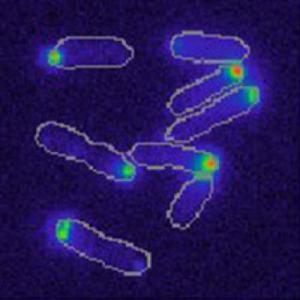Jan 3 2014
Although a population of bacteria may be genetically identical, individual bacteria within that population can act in radically different ways.
 As these bacterial cells divide, chemotaxis machinery (bright blue and red) localize in one daughter cell. Credit: Samuel Miller lab/University of Washington
As these bacterial cells divide, chemotaxis machinery (bright blue and red) localize in one daughter cell. Credit: Samuel Miller lab/University of Washington
This phenomenon is crucial in the bacteria's struggle for survival. The more diversity a population of bacteria has, the more likely it will contain individuals able to take advantage of a new opportunity or overcome a new threat, including the threat posed by an antibiotic.
In a recent study, researchers at the University of Washington showed that when a bacterial cell divides into two daughter cells there can be an uneven distribution of cellular organelles. The resulting cells can behave differently from each other, depending on which parts they received in the split.
"This is another way that cells within a population can diversify. Here we've shown it in a bacterium, but it probably is true for all cells, including human cells," said Dr. Samuel Miller, UW professor of microbiology, genome sciences, and medicine and the paper's senior author.
Bridget Kulasekara, who obtained a Ph.D in the UW Molecular and Cellular Biology Program, was the paper's lead author. Other contributors included: Hemantha Kulasekara, Matthias Christen, and Cassie Kamischke, who work in Miller's lab, and Paul Wiggins, UW assistant professor of physics and bioengineering. The paper appears in the online journal eLife.
In an earlier paper, Miller and his colleagues showed that when bacteria divided, the concentration of an important regulatory molecule, called cyclic diguanosine monophosphate (c-di-GMP). was unevenly distributed between the two progeny. c-di-GMP is a second messenger molecule. That finding was published in the journal Science in 2010.
Second messenger molecules transmit signals from sensors or receptors on the cell's external membrane to targets within the cell, where they can rapidly alter a wide variety of cellular functions, such as metabolism and mobility.
The ability to respond to external stimuli quickly is important for the bacteria's survival. For instance, to stay alive, a bacterium must not hesitate to swim towards nutrients or away from toxins. This directional movement of microorganisms, spurred by the presence of a helpful or harmful substance, is known as chemotaxis.
"The effect of second messengers is almost immediate," said Miller. "They allow bacteria to change their behavior within seconds."
To detect the difference in c-di-GMP levels between cells, the researchers used a technique called Förster resonance energy transfer microscopy, or FRET microscopy. This allowed them to measure nanomolar changes of the concentration of c-di-GMP within individual bacteria as the changes happened second by second.
Different concentrations of c-di-GMP can have a profound influence on a cell's behavior. For example, in the bacteria Pseudomonas aeruginosa, cells with high levels of c-di-GMP tend to remain still, adhere to surfaces and form colonies. Those with low levels, on the other hand, tend to actively swim about by using a corkscrew-shaped propeller located at one end of the bacterium.
In the latest study, the Miller and his colleagues worked out the molecular mechanism behind the difference in c-di-GMP concentrations seen between daughter cells.
When Pseudomonas cells divide, they pinch in half to create two daughter cells. Although the cells are genetically identical, only one daughter cell can inherit the bacterium's single propeller. The other cell can synthesize its own propeller, but immediately after division the two cells are quite different.
What Miller and his coworkers report in the eLife paper is that the daughter cell that inherits the propeller also inherits an enzyme that is closely associated with the propeller that degrades c-di-GMP, as well as the organelle involved in directing movement toward or away from stimuli that activates this enzyme.
Together these two organelles work in concert to lower the concentration of c-di-GMP and control swimming.
"What we have shown is that the uneven inheritance of organelles is another way cells have to create diversity and increase the chances of the survival of its species," Miller said.
He added that his team's findings may help explain how bacteria resist antibiotic treatments by always having some cells in their populations be in a slow-growing, resting state. Since antibiotics target fast-growing cells, these resting cells are more likely to survive the treatment. The findings might also help explain how some bacteria are able to adhere to and colonize surfaces such as urinary catheters, intravenous lines and heart valves.
In ongoing research, Miller's team is trying to get a better understanding of the signals that can change second messenger concentrations very quickly and is screening compounds that could interfere with or alter those signals. Such compounds could be used to combat drug resistance, for instance, or inhibit a bacterium's ability to adhere to surfaces and form slime-like colonies, called biofilms, that are highly resistant to antibiotics.